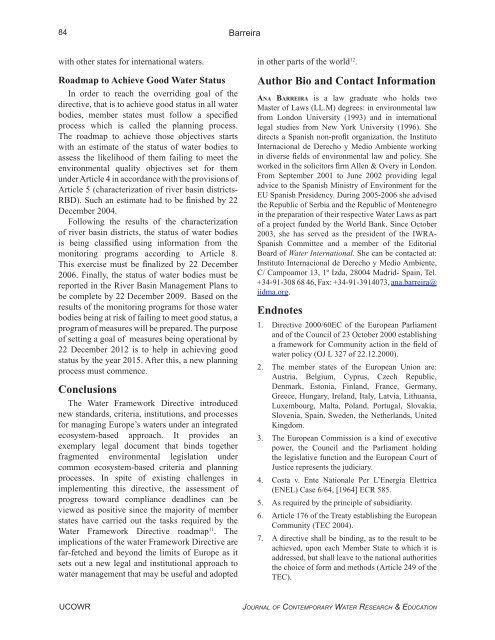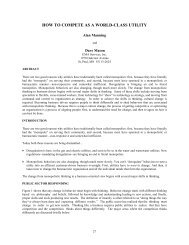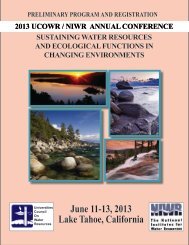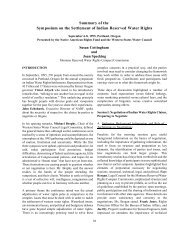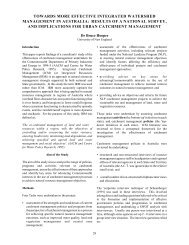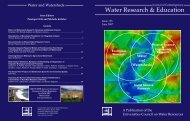Full Journal of Contemporary Water Research and Education, Issue ...
Full Journal of Contemporary Water Research and Education, Issue ...
Full Journal of Contemporary Water Research and Education, Issue ...
You also want an ePaper? Increase the reach of your titles
YUMPU automatically turns print PDFs into web optimized ePapers that Google loves.
84Barreirawith other states for international waters.in other parts <strong>of</strong> the world 12 .Roadmap to Achieve Good <strong>Water</strong> StatusIn order to reach the overriding goal <strong>of</strong> thedirective, that is to achieve good status in all waterbodies, member states must follow a specifiedprocess which is called the planning process.The roadmap to achieve those objectives startswith an estimate <strong>of</strong> the status <strong>of</strong> water bodies toassess the likelihood <strong>of</strong> them failing to meet theenvironmental quality objectives set for themunder Article 4 in accordance with the provisions <strong>of</strong>Article 5 (characterization <strong>of</strong> river basin districts-RBD). Such an estimate had to be finished by 22December 2004.Following the results <strong>of</strong> the characterization<strong>of</strong> river basin districts, the status <strong>of</strong> water bodiesis being classified using information from themonitoring programs according to Article 8.This exercise must be finalized by 22 December2006. Finally, the status <strong>of</strong> water bodies must bereported in the River Basin Management Plans tobe complete by 22 December 2009. Based on theresults <strong>of</strong> the monitoring programs for those waterbodies being at risk <strong>of</strong> failing to meet good status, aprogram <strong>of</strong> measures will be prepared. The purpose<strong>of</strong> setting a goal <strong>of</strong> measures being operational by22 December 2012 is to help in achieving goodstatus by the year 2015. After this, a new planningprocess must commence.ConclusionsThe <strong>Water</strong> Framework Directive introducednew st<strong>and</strong>ards, criteria, institutions, <strong>and</strong> processesfor managing Europe’s waters under an integratedecosystem-based approach. It provides anexemplary legal document that binds togetherfragmented environmental legislation undercommon ecosystem-based criteria <strong>and</strong> planningprocesses. In spite <strong>of</strong> existing challenges inimplementing this directive, the assessment <strong>of</strong>progress toward compliance deadlines can beviewed as positive since the majority <strong>of</strong> memberstates have carried out the tasks required by the<strong>Water</strong> Framework Directive roadmap 11 . Theimplications <strong>of</strong> the water Framework Directive arefar-fetched <strong>and</strong> beyond the limits <strong>of</strong> Europe as itsets out a new legal <strong>and</strong> institutional approach towater management that may be useful <strong>and</strong> adoptedAuthor Bio <strong>and</strong> Contact InformationANA BARREIRA is a law graduate who holds twoMaster <strong>of</strong> Laws (LL.M) degrees: in environmental lawfrom London University (1993) <strong>and</strong> in internationallegal studies from New York University (1996). Shedirects a Spanish non-pr<strong>of</strong>it organization, the InstitutoInternacional de Derecho y Medio Ambiente workingin diverse fields <strong>of</strong> environmental law <strong>and</strong> policy. Sheworked in the solicitors firm Allen & Overy in London.From September 2001 to June 2002 providing legaladvice to the Spanish Ministry <strong>of</strong> Environment for theEU Spanish Presidency. During 2005-2006 she advisedthe Republic <strong>of</strong> Serbia <strong>and</strong> the Republic <strong>of</strong> Montenegroin the preparation <strong>of</strong> their respective <strong>Water</strong> Laws as part<strong>of</strong> a project funded by the World Bank. Since October2003, she has served as the president <strong>of</strong> the IWRA-Spanish Committee <strong>and</strong> a member <strong>of</strong> the EditorialBoard <strong>of</strong> <strong>Water</strong> International. She can be contacted at:Instituto Internacional de Derecho y Medio Ambiente,C/ Campoamor 13, 1º Izda, 28004 Madrid- Spain, Tel.+34-91-308 68 46, Fax: +34-91-3914073, ana.barreira@iidma.org.Endnotes1.2.3.4.5.6.7.Directive 2000/60EC <strong>of</strong> the European Parliament<strong>and</strong> <strong>of</strong> the Council <strong>of</strong> 23 October 2000 establishinga framework for Community action in the field <strong>of</strong>water policy (OJ L 327 <strong>of</strong> 22.12.2000).The member states <strong>of</strong> the European Union are:Austria, Belgium, Cyprus, Czech Republic,Denmark, Estonia, Finl<strong>and</strong>, France, Germany,Greece, Hungary, Irel<strong>and</strong>, Italy, Latvia, Lithuania,Luxembourg, Malta, Pol<strong>and</strong>, Portugal, Slovakia,Slovenia, Spain, Sweden, the Netherl<strong>and</strong>s, UnitedKingdom.The European Commission is a kind <strong>of</strong> executivepower, the Council <strong>and</strong> the Parliament holdingthe legislative function <strong>and</strong> the European Court <strong>of</strong>Justice represents the judiciary.Costa v. Ente Nationale Per L’Energia Elettrica(ENEL) Case 6/64, [1964] ECR 585.As required by the principle <strong>of</strong> subsidiarity.Article 176 <strong>of</strong> the Treaty establishing the EuropeanCommunity (TEC 2004).A directive shall be binding, as to the result to beachieved, upon each Member State to which it isaddressed, but shall leave to the national authoritiesthe choice <strong>of</strong> form <strong>and</strong> methods (Article 249 <strong>of</strong> theTEC).UCOWRJOURNAL OF CONTEMPORARY WATER RESEARCH & EDUCATION


